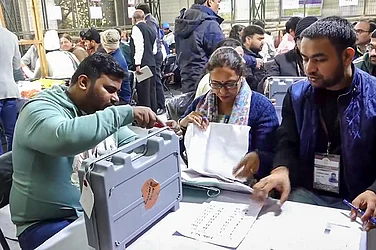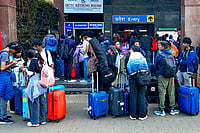The critical remarks made by Chairman of the National Commission for the Protection of Child Rights (NCPCR) Priyank Kanoongo regarding the functioning of madrasas sparked a debate in Kerala. It was highlighted that the recommendations made by the commission were not applicable to the state for two reasons —firstly, the madrasas in Kerala are not funded by the government; secondly, these institutions focus exclusively on religious education and does not interfere with children's formal schooling. However, the controversy intensified when Kanoongo disputed these claims, specifically asserting that he had evidence of state government's financial support to Kerala's madrasas.
The chairman was allegedly reproducing parts of a 'WhatsApp theory' that went viral a few years ago. The allegation, which had been debunked by many, was that madrasa teachers get salaries from the government. This emerged earlier in 2021 when the LDF government came back to power for a second consecutive term. In response to the 'viral message', the Chief Minister made a statement in the Assembly denying these claims.
In this context, Outlook looks into the facts about madrasas in Kerala. Are they funded by the government? Do they violate Right To Education mandates? Is the government paying the salary of madrasa teachers? Is there any special treatment given to madrasa teachers in Kerala by the government?
No aid from the government
One of the most persistent misconceptions about Kerala's madrasas concerns their funding structure. Contrary to widespread belief about government funding, these institutions primarily operate through community funding.
According to recent data, there are around 29,000 madrasas in Kerala, all run by religious education boards belonging to different streams of the Muslim faith such as Sunni, Mujahid, and Jamaat-e-Islami. All these boards mobilise funds from within the community and pay teachers associated with them. There are around three lakh madrasa teachers in Kerala working under various boards. The government has little involvement in the running of these madrasas.

Do they violate Right to Education rules?
The madrasas in Kerala provide only religious education and not formal education. The children studying in madrasas are enrolled in formal schools, either private or public, for modern education. Also, no non-Muslim students are apparently enrolled in madrasas in Kerala.
The school enrolment in Kerala is 100 per cent, which indicates universal education. According to the Economic Review 2023, Kerala has the lowest dropout rate in schools as well. Interestingly, Malappuram, which is the only Muslim-majority district in Kerala, has the largest number of schools (1,572) in the State.
Kerala Madrassa Teachers' Welfare Board
The Kerala Madrassa Teachers' Welfare Board, established in 2019, operates as a statutory body under the Kerala Madrassa Teachers' Welfare Fund Act. The Board's primary responsibility is to provide pension benefits to eligible madrasa teachers. To qualify for pension, a teacher must reach the age of 60 and have contributed to the fund for a minimum of five years. The pension amount varies based on the duration of their contributions.
Under the current structure, both teachers and management committees participate in the fund's contribution system. Each madrasa teacher who enrols as a member must contribute ₹50 monthly to the fund. The management committee matches this amount by contributing ₹50 per month for each madrasa teacher under their supervision. These pooled contributions form the basis of the pension fund.
While the government provided an initial corpus fund to establish the Board, it does not make any on-going financial contributions. The Board operates independently without regular government funding or budget allocations.
Why a Welfare Board for Madrasa Teachers?
The Madrassa Teachers' Welfare Fund Board is one among the 16 such statutory welfare boards in Kerala intended to ensure pension and other benefits for workers. Other such welfare boards are Toddy Workers' Welfare Fund Board, Kerala Agricultural Workers' Welfare Fund Board, Kerala Handloom Workers' Welfare Fund Board, and Kerala Unorganised Workers' Social Security Board.
The madrasas in Kerala have an older history compared to those in other States as Islam came to India through Kerala. These institutions first emerged alongside mosques established by Arab traders in the 16th and 17th centuries, initially focusing on Quran recitation and basic Islamic studies through informal structures where individual scholars taught students. During the colonial period, madrasas began to adopt a more structured organizations and systematic curricula, leading to the establishment of dedicated buildings for religious education.
The post-Independence era marked a significant turning point in the evolution of Kerala's madrasa system. This period saw the modernisation of teaching methods and the introduction of Malayalam as a medium of instruction, making religious education more accessible to the local population. A unique script called 'Arabi Malayalam' has evolved through the Madrassa curriculum in Kerala. Arabi Malayalam is nothing but writing Malayalam words and sentences in Arabic letters. This makes learning easier for children.
Madrasas in Kerala generally function for two hours in the morning or evening without disturbing school hours. There are also madrasas that function only on holidays. The Samastha Madrassa Management Association has recently said that there is a decline in the number of students in madrasas as the dropout rate is high. Abdul Samad Pookkottoor, a religious scholar and an office bearer of the Association, said that the majority of students leave madrasas by fifth grade. This indicates a preference for modern education among the Muslim population of the state.










.jpg?auto=format%2Ccompress&fit=max&format=webp&w=768&dpr=1.0)


















